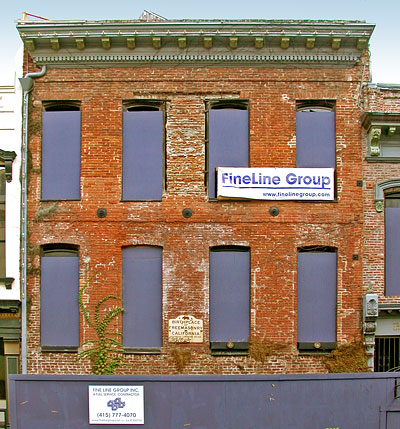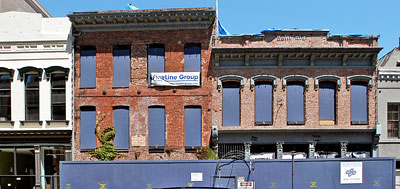San Francisco Landmarks
Genella Building
726-728 Montgomery Street Between Washington and Jackson
Built 1853
The foundation of this three-story brick building was constructed of the same heavy timbers, crisscrossed like a raft, as is its neighbor the Belli Building. Less ornate in its decoration than the Belli Building, it has gold and black trim on the first floor window frames which contrasts with the red brick walls.
Although the present owner, Melvin Belli, considers the building to have been constructed in 1849, most records indicate that it was erected in 1853-54 by Joseph Genella for his china and glassware business as well as his residence. Sources indicate that Genella had moved by 1860 although he maintained ownership of the building for some time Tenants during this period included bullion dealers, merchandise brokers, a Spanish newspaper (La Voz de Chile), and mining company offices.
A plaque here certifies that the first Masonic Lodge meeting in San Francisco was held on the site in 1849.
As early as 1854, the upper floor was used as a meeting hall for the Odd Fellows. The use of the area for such purposes continued through the 1860's and l870's with the Ancient Jewish Order KSB and the American Protestant Association holding lodge meetings here. Later, perhaps in the l880's, the third floor became known as Xenon's Hall.
A bath house in the 1880's, the building housed a puppet theater in the l920's and 1930's as well as a garment factory in the 1940's before being restored in the 1950's to it's present [1968] use as offices and an antique shop.
Source: Planning Commission Resolution No. 6275 dated 3 October 1968.

The Genella Building and the adjacent Belli Building were vacated after they were structurally damaged by the Loma Prieta Earthquake on 17 October 1989. The buildings were vacant for over twenty-five years.
Both buildings were eventually gutted and rebuilt as apartments. Only the façades were saved.

The Genella Building is in the Jackson Square Historic District.

Façadism
Wikipedia defines Façadism (or Façadomy) as the practice of demolishing a building but leaving its façade intact for the purposes of building new structures in it or around it.
The International Charter for the Conservation and Restoration of Monuments and Sites (The Venice Charter of 1964) provided the doctrinal foundation for the modern preservation movement.
Although the United States did not participate in the preparation of the charter, the charter provided the basis for the Secretary of Interior's Standards for Historic Preservation. US/ICOMOS was founded in the 1960s to foster heritage conservation and historic preservation.
Article 1 of the Venice Charter
The concept of a historic monument embraces not only the single architectural work but also the urban or rural setting in which is found the evidence of a particular civilization, a significant development or a historic event. This applies not only to great works of art but also to more modest works of the past which have acquired cultural significance with the passing of time.
Article 7 of the Venice Charter
A monument is inseparable from the history to which it bears witness and from the setting in which it occurs. The moving of all or part of a monument cannot be allowed except where the safeguarding of that monument demands it or where it is justified by national or international interest of paramount importance.
Article 13 of the Venice Charter
Additions cannot be allowed except in so far as they do not detract from the interesting parts of the building, its traditional setting, the balance of its composition and its relation with its surroundings.
Paul Golderberger, writing in the New York Times on 15 July 1985 (Façadism on the Rise: Preservation or Illusion?), gives an argument against urban façadism.
For façadism holds out a great temptation. It seems, on the surface, to give both sides what they want. The small, older buildings valued by preservationists appear to be saved, while the large new ones developers seek can still be built.Façadism in San Francisco:But while façadism pretends to a certain earnestness, it is at bottom rather pernicious. For the compromise it represents is not really preservation at all. To save only the facade of a building is not to save its essence; it is to turn the building into a stage set, into a cute toy intended to make a skyscraper more palatable. And the street becomes a kind of Disneyland of false fronts.
- Belli Building, 722 Montgomery Street
- Borel and Company, 440 Montgomery Street
- Engine Company No. 14 , 1047 McAllister Street
- Genella Building, 726-728 Montgomery Street
- Hoffmann Grill Building, 619 Market Street
- Italian American Bank, 460 Montgomery Street
- South End District
- United States Mint & Subtreasury, 608 Commercial Street
- Minden Butter Manufacturing Company, Minden, NV

